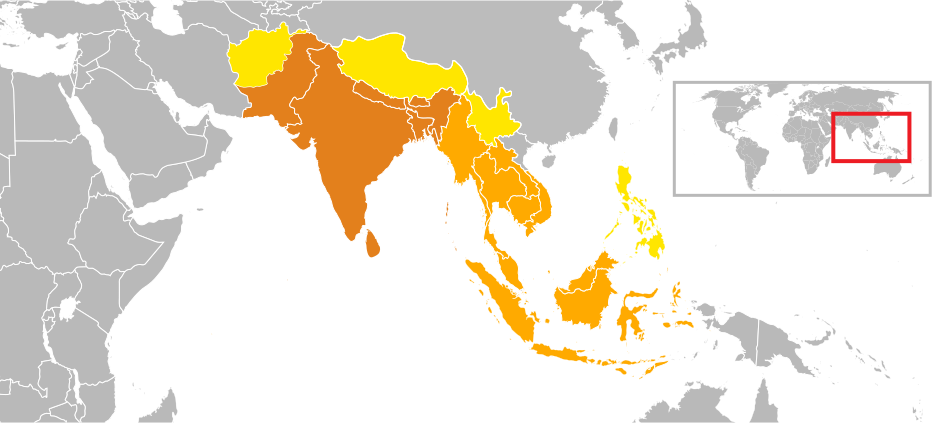INDIC
BANNED

- Joined
- Jun 7, 2012
- Messages
- 18,512
- Reaction score
- -12
- Country
- Location
Follow along with the video below to see how to install our site as a web app on your home screen.
Note: This feature may not be available in some browsers.


Champa was an Indianized Empire, Philippines too had Indian cultural influence.


He is talking about the Indianised kingdoms of Philippines before the arrival of the Spanish.


There is no such term as Indianized. There was no country called India back then.
Philipines and Vietnam were never Hindu, there were trade ties with South Asia Hindu kingdoms. The islands around Sulawesi were never HIndu either too.
As always, Indians love to post fake map.


Greater India was the historical extent of the culture of India beyond the Indian Subcontinent. This particularly concerns the spread of Hinduism and Buddhism by the travelers and traders of the 5th to 15th centuries, but may also refer to the spread of Hinduism and Buddhism from India to Central Asia and China by the Silk Road during the early centuries of the Common Era. Particularly Southeast Asia was heavily influenced by the east Indian Gupta Empire and south Indian Pallava Dynasty during ancient and medieval period which led to the establishment of Indianised kingdoms in Southeast Asia.




Seems Chinese were living in their caves back then.

The Philippines were mostly ruled by Indianised kingdoms that used the old Hindu calendar and a script that is derivedThere is no such term as Indianized. There was no country called India back then.
Philipines and Vietnam were never Hindu, there were trade ties with South Asia Hindu kingdoms. The islands around Sulawesi were never HIndu either.
As always, Indians love to post fake map.

You're the delusional frog in the dung, India was formed in 1947.


There is no such term as Indianized. There was no country called India back then.
Philipines and Vietnam were never Hindu, there were trade ties with South Asia Hindu kingdoms. The islands around Sulawesi were never HIndu either too.
As always, Indians love to post fake map.
The concept of the Indianised kingdoms, first described by George Coedès, is based on Hindu and Buddhist cultural and economic influences in Southeast Asia.[12] Butuan, Champa, Dvaravati, Funan, Gangga Negara, Kadaram, Kalingga, Kutai, Langkasuka, Pagan, Pan Pan, Po-ni, Tarumanagara and Tondo were among the earliest Hindu kingdoms in Southeast Asia, established around the 1st to 4th centuries CE. Despite being culturally akin to Hindu cultures, these kingdoms were indigenous and independent of the Indian mainland. States such as Srivijaya, Majapahit and the Khmer empire developed territories and economies that rivaled those in India itself. Borobudur in Java, for example, is the largest Buddhist monument ever built.[13] Coedès has been criticised for understating the Southeast Asian element of these kingdoms, in an unconscious echo of the European "civilising mission."[14]
The end of Philippine prehistory is 900 CE,[31] the date inscribed in the oldest Philippine document found so far, the Laguna Copperplate Inscription. From the details of the document, written in Kawi script, the bearer of a debt, Namwaran, along with his children Lady Angkatan and Bukah, are cleared of a debt by the ruler of Tondo. From the various Sanskrit terms and titles seen in the document, the culture and society of Manila Bay was that of a Hindu–Old Malay amalgamation
By year 1011 Rajah Sri Bata Shaja, the monarch of the Indianized Rajahnate of Butuan, a maritime-state famous for its goldwork[44] sent a trade envoy under ambassador Likan-shieh to the Chinese Imperial Court demanding equal diplomatic status with other states.[45] The request being approved, it opened up direct commercial links with the Rajahnate of Butuan and the Chinese Empire thereby diminishing the monopoly on Chinese trade previously enjoyed by their rivals the Dynasty of Tondo and the Champa civilization.[46] Evidence of the existence of this rajahnate is given by the Butuan Silver Paleograph.[47]
Before the Spanish period, the archipelagoes of Southeast Asia were under the influence of traders from the Hindu-Malayan culture, such as the Majapahit Empire, which was then supplanted by Islamic teaching by Muslims traders from Gujarat, India. Influences from the Indian subcontinent may be traced earlier to before the arrival of the Arabs and the Europeans during the 15th and 16th centuries respectively. The rulers of many of the islands were called Rajas, or Rajahs. An example would be the Visayas, said to be named after the last Southeast Hindu Prince Srivijaya.[citation needed]
Spanish era
Further adherence to Hinduism was superseded by the advent of Islam brought to the archipelago By Indonesian, Malay, and Arab missionaries in the 14th century, as well as the arrival of Christianity with the Spaniards in 1521. Local Rajahs gave tribute to such empires such as the Buddhist Sri Vijaya and/or Hindu Majapahit.
American period
Ancient statues of the Hindu gods were hidden to prevent their destruction by Christians who worshiped a single deity. One such statue, known as 'Golden Tara', is a 4-pound gold statue of an Indo-Malayan goddess found in Mindanao in 1917, which now sits in the Field Museum of Natural History in Chicago, and is dated from the period 13th to early 14th centuries. Another gold artifact, this time found on Palawan, is an image of Garuda, the bird who is the mount of Vishnu.[citation needed]

I think he is talking about this:
Philippines:
Though Hinduism in Vietnam was always too low to call it Hindu country, as you mentioned.



Its still 2 years elder than China which was formed in 1949.
List of warlords and military cliques in the Warlord Era - Wikipedia, the free encyclopedia

The World Factbook
India
Independence from the United Kingdom
- Dominion15 August 1947
- Republic26 January 1950
China
Formation
- Unification of China under the Qin Dynasty221 BC
- Republic established1 January 1912
- People's Republic proclaimed1 October 1949


